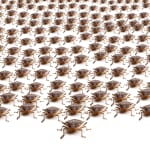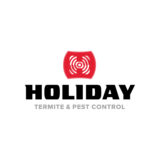Stink Bug Control

Stink bugs are a common household pest on the east coast. The most common species found in Northern Virginia is the Brown Marmorated stink bug, a species identified by a dark, shield-like exoskeleton and black ridges. Stink bugs first appeared in Pennsylvania but, due to rapid reproduction and high survivability rates, quickly spread across the country. Currently, stink bugs are reported in over 38 states. Fortunately, while one of the more offensive nuisances to be repelled from homes, they do not pose any significant risk to either home structure or human health. However, this certainly does not mean anyone wants to share their space with these smelly little insects. With just a little research and small household changes, any homeowner can learn to control these annoyances.

#1 The Stink in Stink Bug
Anyone who has handled one of these pests can attest to the fact that they are aptly named. This stink is a form of self-defense to the stink bug, a response to fear or intimidation. When stressed or frightened stink bugs emit a thin, foul liquid from their thorax. To most predators, this stench will dissuade them from turning the stink bug into a meal. The reaction is similar to the mechanism used to emit pheromones in an attempt to attract a mate.
#2 Fight Stink Bug Infestation before it starts
The most effective form of stink bug prevention is physical exclusion. Preventing stink bugs from entering a home prevents more rash steps to be taken later such as chemical extermination. Physical exclusion is best performed early in the summer, this will prevent stink bugs from wintering (or hunkering down for the winter) in your home. Exclusion can be achieved by sealing any and all cracks in windows and doors or any other access point running from the outside. Caulk or screening can be used to seal of most of the possible entrances.
#3 Anatomy
Stink Bugs are sometimes referred to as shield bugs because of the shape of their hard exoskeleton. A stink bug’s exoskeleton covers the entirety of its body, acting as effective protection from outside dangers. The Brown Marmorated stink bug typically has a dark exoskeleton with dark and light ridges alternating around the shell. The layers beneath the exoskeleton are far more soft and unprotected, including the thorax, wings (on older stink bugs) and legs. For easy identification, a Brown Moarmorated stink bug will also have thin white bands around both antenna and all of its legs.
#4 Garden Grub
While stink bugs do not pose a threat to home or health, they certainly can be damaging to gardens. Since stink bugs greatly prefer to lay their eggs outside (usually during mid-spring) both nymphs and adults live primarily off of the garden vegetables. The most at risk plant in the garden is the tomato. Stink bug damage to gardens can be identified by obvious unevenness on the outside of the vegtable and dark brown spots throughout the inside. Stink Bug infestations in gardens reach their peak in late summer. Unfortunately, killing stink bugs in the garden is uniquely difficult due to the bugs naturally high toleration to most common pesticides. However, Pyrethroid insecticide can be relatively effective at killing these infestations.
#5 Fighting From Inside the Home
Once stink bugs have managed to move into your home, the fight becomes much slower and frustrating. Most pesticides will have little to no effect, so ultimately the best form of fighting them is to just vacuum them up whenever possible. Unfortunately, over time this will lead to your vacuum cleaner picking up the offensive smell. Another tried and true method for single insect removal is flushing the little buggers down the toilet. There are several types of effective insecticides that will kill stink bugs, however use them very sparingly, as dead stink bugs that go unfound or unremoved could attract even more annoying pests such as carpet beetles.
